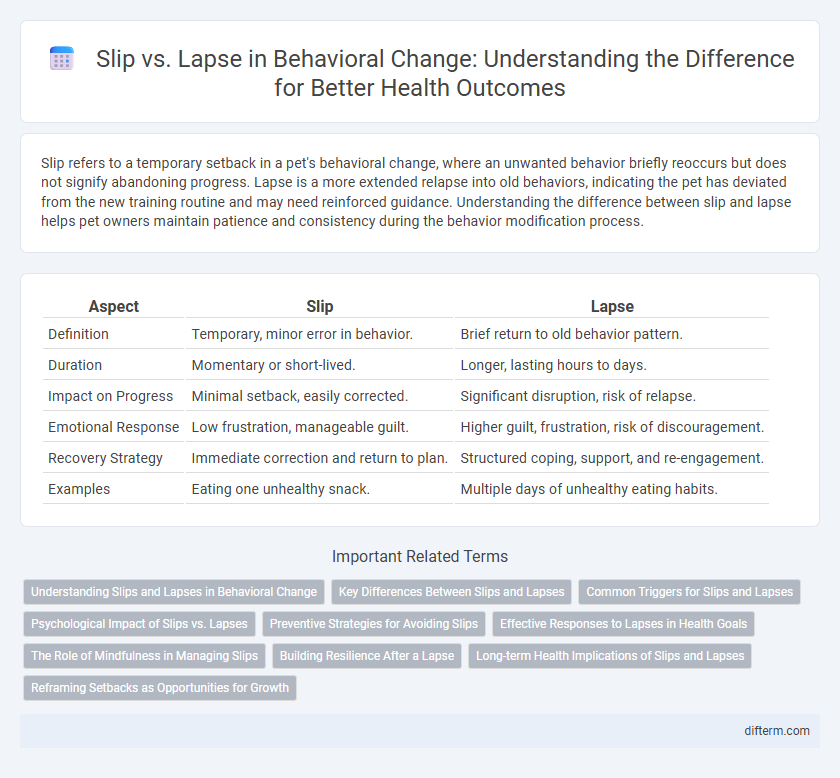Slip refers to a temporary setback in a pet's behavioral change, where an unwanted behavior briefly reoccurs but does not signify abandoning progress. Lapse is a more extended relapse into old behaviors, indicating the pet has deviated from the new training routine and may need reinforced guidance. Understanding the difference between slip and lapse helps pet owners maintain patience and consistency during the behavior modification process.
Table of Comparison
| Aspect | Slip | Lapse |
|---|---|---|
| Definition | Temporary, minor error in behavior. | Brief return to old behavior pattern. |
| Duration | Momentary or short-lived. | Longer, lasting hours to days. |
| Impact on Progress | Minimal setback, easily corrected. | Significant disruption, risk of relapse. |
| Emotional Response | Low frustration, manageable guilt. | Higher guilt, frustration, risk of discouragement. |
| Recovery Strategy | Immediate correction and return to plan. | Structured coping, support, and re-engagement. |
| Examples | Eating one unhealthy snack. | Multiple days of unhealthy eating habits. |
Understanding Slips and Lapses in Behavioral Change
Slips and lapses represent common setbacks in behavioral change, where slips are brief, unintentional deviations from desired behavior, and lapses indicate short-term, often repeated failures to maintain change. Recognizing these distinct patterns helps in tailoring interventions that reinforce coping strategies and resilience. Effective behavioral health programs emphasize awareness of triggers and proactive problem-solving to minimize the impact of slips and lapses on long-term success.
Key Differences Between Slips and Lapses
Slips occur when an individual unintentionally deviates from a desired behavior due to momentary distraction or error, often without conscious awareness, whereas lapses involve a temporary failure in maintaining behavioral change, typically reflecting a brief return to old habits. Slips are generally isolated incidents that do not signify a loss of commitment, while lapses represent a more significant disruption in adherence to health goals, often linked to emotional or environmental triggers. Understanding these distinctions is critical for designing effective relapse prevention strategies in behavioral health interventions.
Common Triggers for Slips and Lapses
Common triggers for slips in behavioral change include stress, fatigue, and environmental cues that prompt automatic responses conflicting with new habits. Lapses often occur due to emotional distress, social pressure, or temporary disruptions in routine that reduce self-control and increase vulnerability to old behaviors. Identifying these triggers enables the development of targeted strategies for relapse prevention and sustainable health improvements.
Psychological Impact of Slips vs. Lapses
Slips in behavioral change often trigger feelings of guilt and decreased self-efficacy, intensifying stress and potentially hindering long-term progress. Lapses, viewed as temporary setbacks rather than failures, tend to elicit less psychological distress and encourage resilience and recommitment to goals. Understanding these distinctions improves strategies in health psychology to support sustained behavior modification and relapse prevention.
Preventive Strategies for Avoiding Slips
Preventive strategies for avoiding slips in behavioral change include establishing clear, achievable goals and maintaining consistent self-monitoring to track progress. Creating supportive environments by removing triggers and implementing routine behavioral cues enhances adherence to new habits. Utilizing social support networks and cognitive-behavioral techniques further strengthens resilience against momentary lapses.
Effective Responses to Lapses in Health Goals
Effective responses to lapses in health goals include recognizing the lapse without self-judgment and quickly recommitting to positive behaviors. Employing strategies such as tracking progress, seeking social support, and adjusting goals can prevent a single setback from escalating into a full relapse. Understanding that lapses are common in behavioral change enables individuals to maintain long-term motivation and resilience in their health journey.
The Role of Mindfulness in Managing Slips
Mindfulness plays a crucial role in managing slips during behavioral change by increasing awareness of triggers and automatic reactions. This intentional focus on the present moment helps individuals recognize early signs of a slip, enabling timely intervention before it escalates into a full lapse. Research indicates that mindfulness-based practices reduce relapse rates by fostering self-regulation and resilience in health behavior modification.
Building Resilience After a Lapse
Building resilience after a lapse in behavioral change involves recognizing slips as temporary setbacks rather than failures, which fosters a growth mindset crucial for long-term health improvement. Reinforcing motivation through self-compassion and analyzing triggers enhances adaptive coping mechanisms and supports sustained habit formation. Integrating evidence-based strategies such as mindful reflection and social support accelerates recovery and strengthens commitment to health goals.
Long-term Health Implications of Slips and Lapses
Slips and lapses in behavioral change both disrupt health routines, but slips are brief, often isolated errors, while lapses signify a return to previous unhealthy behaviors. Repeated lapses can undermine long-term health goals, increasing risks of chronic diseases such as diabetes or heart disease. Effective management of slips prevents lapses, supporting sustained health improvements and behavioral consistency.
Reframing Setbacks as Opportunities for Growth
A slip in behavioral change is a temporary setback where an individual briefly reverts to old habits, whereas a lapse signifies a more prolonged or recurrent return to previous behaviors. Reframing these setbacks as opportunities for growth encourages resilience by viewing mistakes as learning experiences that strengthen long-term commitment. Emphasizing self-compassion and adaptive strategies during slips and lapses enhances motivation and supports sustained health improvements.
Slip vs Lapse (in behavioral change) Infographic

 difterm.com
difterm.com